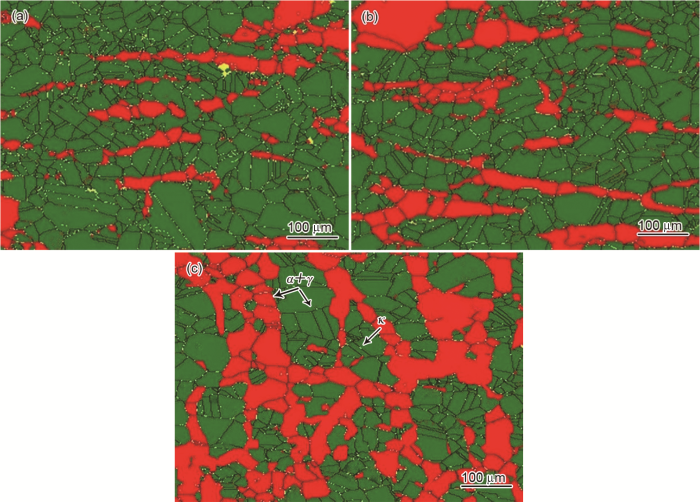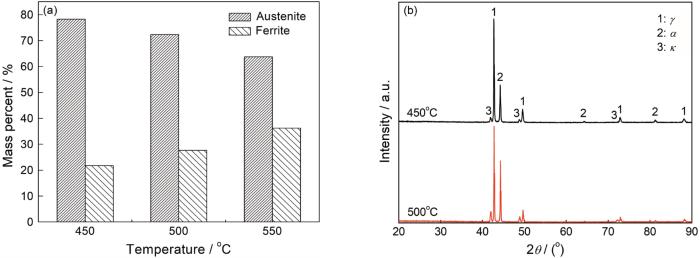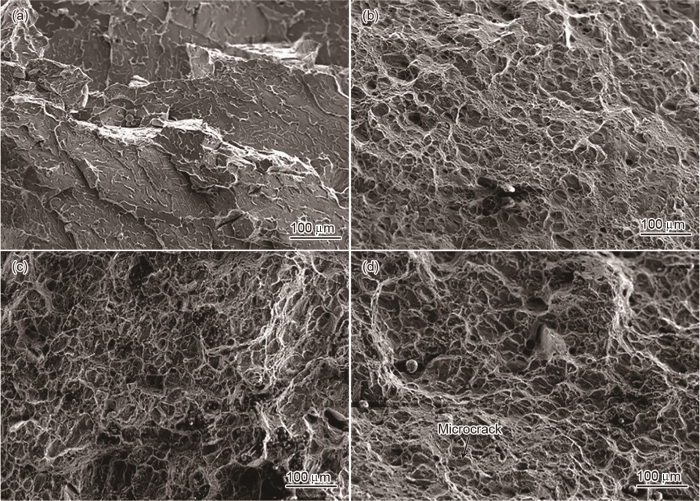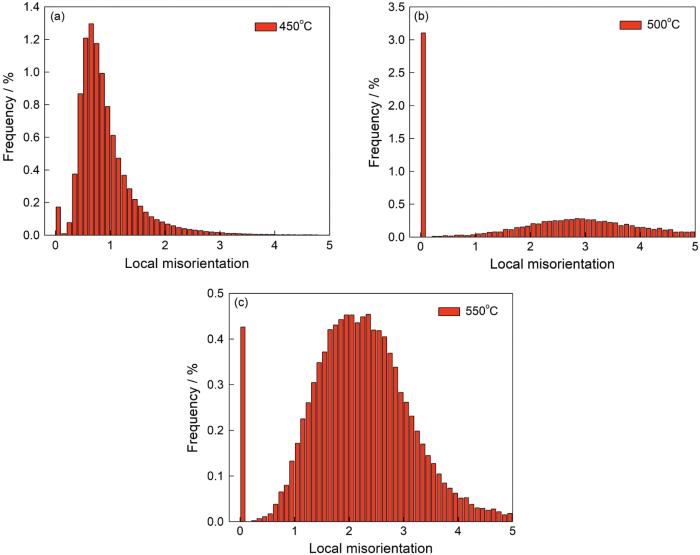Fe-Mn-Al-C系低密度钢,因具有优异的力学性能和轻量化效果受到极大的关注。尤其是在汽车工业领域,Fe-Mn-Al-C钢的使用对于汽车自身的降重和安全更极为重要[1,2]。对Fe-Mn-Al-C钢的热处理,多采用固溶+时效。研究表明[3~7]:在热处理过程中κ碳化物以调幅分解的方式从奥氏体基体中共格析出,有利于提高钢的强韧性。同时,钢中的Mn、Al和C能显著提高层错能。高层错能材料,其变形机理不同于TRIP(相变诱导塑性)和TWIP(孪晶诱导塑性)效应[9~12]。Fe-Mn-Al-C系低密度钢的力学性能,与其晶粒尺寸密切相关。Lee Sang-In等[13]研究了奥氏体晶粒尺寸不同的高锰钢的拉伸性能,结果表明:奥氏体晶粒尺寸的减小使机械孪晶的生成和晶粒细化,使其屈服强度、拉伸强度和塑性提高。但是,晶粒细化对Fe-Mn-Al-C钢力学性能的提高并没有决定性的作用。Saha R等[14]和Tian Y Z等[15]分别研究了晶粒尺寸为400nm和550nm的超细晶高锰钢的力学性能,发现后者的屈服强度和抗拉强度都优于前者。这意味着,相应的晶粒尺寸与材料强度的相关性也有不同。本文对Fe-30Mn-9Al-0.9C-0.45Mo低密度钢进行不同温度的时效处理,研究时效温度对Fe-30Mn-9Al-0.9C-0.45Mo低密度钢的组织结构和力学性能影响,并分析力学性能与奥氏体晶粒尺寸之间的关系以揭示其变形机制。
1 实验方法
用真空感应炉冶炼实验用钢,其化学成分(质量分数,%)为0.90C、30.00Mn、9.00Al、0.45Mo,余量为Fe。将钢锭在1170℃均匀化处理2 h后锻成尺寸为30 mm×30 mm×30 mm的方坯,然后在加热炉中升温至1150℃并保温2 h。将钢进行7道次热轧变形,开轧温度为1050℃,终轧温度为850℃,轧后厚度为5.00 mm。将其在1050℃固溶处理1 h水淬后,再分别在450、500、550℃保温12 h,然后水冷至室温。
根据国家标准GB/T 228.1-2010《金属材料 拉伸试验 第一部分:室温试验方法》,用SHT4106型万能试验机进行拉伸测试。将金相试样打磨抛光后用4%的硝酸酒精溶液腐蚀,在澳普光电UMT203I型光学显微镜(OM)下观察组织形貌;用JSM-6510LV型扫描电镜(SEM)观察拉伸断口的形貌。用Ultima IV型X射线衍射仪分析实验钢的物相组成。用JEOF JSM-7800F型电子背散射衍射(EBSD)表征时效后钢的相分布。将变形后的拉伸试样打磨和离子减薄,用FEI Tecnai G2F20型透射电子显微镜(TEM)分析其位错微观结构。
2 结果和讨论
2.1 钢的组织和相的演变
图1给出了实验钢的固溶态和在不同温度时效处理后的显微组织。如图1a所示,在固溶处理后实验钢的奥氏体基体上不均匀地分布着粗大的铁素体,奥氏体晶内有大量的退火孪晶和弥散分布的未溶碳化物(Fe,Mn)3AlC[3,6]。这种未溶碳化物有助于提高钢的强度,但是使其延伸率降低。由图1b可见,时效处理后钢的组织为奥氏体+铁素体组织。随着时效温度的提高退火孪晶的含量提高,意味着晶粒长大了,如图1c和d所示。统计时效后实验钢奥氏体的晶粒尺寸,结果如图2所示。可以看出,在450℃时效后钢的晶粒尺寸为25~30 μm,正态分布曲线相对均匀,没有明显的波动。随着时效温度提高到550℃最大晶粒尺寸达到120 μm,平均晶粒尺寸为41 μm,正态分布曲线峰值较为集中,奥氏体晶粒明显长大。主要原因是,随着时效温度的提高和长时间保温,晶粒长大驱动力的增大使晶粒粗化。
图1
图1
在不同温度时效12 h后实验钢的显微组织
Fig.1
Optical micrographs of the experimental steel after solution treated at different aging temperatures for 12 h (a) solid solution state; (b) aged at 450℃; (c) aged at 500℃; (d) aged at 550℃
图2
图2
试验钢不同温度时效后奥氏体晶粒尺寸分布图
Fig.2
grain size distribution of austenite in experimental steel after aging at different temperatures (a) aged at 450℃; (b) aged at 500℃; (c) aged at 550℃
为了进一步分析组织的演变规律,用EBSD表征了在不同温度时效后实验钢的相分布,结果如图3所示。图3中红色代表铁素体相,绿色代表奥氏体相,黄色代表析出相,为κ碳化物。统计了在不同温度时效后钢中铁素体、奥氏体及析出相的含量,结果如图4所示。由图4a可见,在450℃时效后奥氏体的质量分数最高为78.3%,而铁素体的质量分数最低;随着时效温度的提高奥氏体的质量分数逐渐降低而铁素体的含量提高,在550℃时效后铁素体的质量分数达到最大值36.3%。这表明,铁素体组织的长大程度超过了奥氏体。铁素体的体积分数和分布对钢的塑性影响较大,而对强度影响较小。由图3c可见,在550℃时效后钢中晶界处和晶内有少量点状κ碳化物析出,不均匀地分布在奥氏体基体上。在拉伸变形过程中κ碳化物同位错相切随基体一起变形,使实验钢的强度提高。图4b给出了实验钢在450~500℃时效后的XRD谱,可见其组织主要为奥氏体+铁素体+κ碳化物。与在450℃和500℃时效后的组织对比可以发现:奥氏体、铁素体组织的变化与EBSD图中的相分布一致,并且κ碳化物变化较为明显,随着时效温度的提高κ碳化物的峰值升高。这表明,时效温度的提高增大了促进碳化物析出的驱动力,使κ碳化物更容易析出。
图3
图3
EBSD表征在不同温度时效后实验钢的相分布
Fig.3
EBSD characterizes of the phase distribution of the experimental steel after aging at different temperature (a) 450℃; (b) 500℃; (c) 550℃
图4
图4
不同时效温度下奥氏体、铁素体质量分数和XRD谱
Fig.4
Mass fraction of austenite and ferrite and XRD spectra at different aging temperatures
图5
图5
550℃时效后钢中铁素体析出相形貌和XRD谱
Fig.5
Morphology of ferrite precipitates and XRD spectra of steel aged at 550 ℃
2.2 力学性能和断口形貌
表1 实验钢在不同温度时效12 h后的力学性能
Table 1
| Temperature/℃ | Rm/MPa | Rp0.2/MPa | Elongation/% | Rm×Elongation/GPa·% |
|---|---|---|---|---|
| Solid solution | 1155 | - | - | - |
| 450 | 863 | 567 | 56.1 | 48.4 |
| 500 | 873 | 575 | 55.0 | 48.0 |
| 550 | 866 | 713 | 10.1 | 8.7 |
图6给出了在450~550℃时效后试样的拉伸工程应力-应变曲线和钢板各项力学性能随温度的变化。由图6a可见,实验钢在塑性变形过程中连续屈服,没有明显的屈服平台;应力与应变之间的变化近似于线性关系,且峰值应力随着时效温度的提高而增大。相对于固溶态钢板,时效后试样的抗拉强度降低而塑性明显提高。这表明,时效处理能很好地消除实验钢在热轧时产生的加工硬化,使试验钢的塑性有较大的提高;随着时效温度的提高,实验钢在450℃时效后其高强度和高塑性有良好的组合;在550℃时效后抗拉强度变化不大但是塑性明显降低。由图6b可以看出,强塑积和断后伸长率几乎同步变化。在450℃时效后强塑积达到最高值48.4 GPa·%;在500℃时效后塑性微降到55.0%,强塑积数值微降到48.0 GPa·%;而在高于500℃的温度时效后塑性明显降低到10.1%,强塑性数值降到最低值8.7 GPa·%。与固溶态实验钢相比,在450~500℃时效可明显改善其力学性能。
图6
图6
时效钢的工程应力-应变曲线和力学性能随时效温度的变化
Fig.6
engineering stress-strain curve and mechanical properties of aged steel with aging temperature (a) engineering stress-strain curves; (b) Rm, elongation, Rp0.2, and Rm×elongation
图7
图7
试验钢拉伸断口形貌
Fig.7
Tensile fracture morphology of experimental steel (a) solid solution; (b) aged at 450℃; (c) aged at 500℃; (d) aged at 550℃
2.3 讨论
图8
图8
实验钢在不同温度时效后的KAM图
Fig.8
KAM diagram of experimental steel after aging at different temperatures (a) aged at 450℃; (b) aged at 500℃; (c) aged at 550℃
表2 实验钢拉伸变形后的KAM分布、平均KAM值以及位错密度
Table 2
| Aging temperature | KAM distribution | Average | Dislocation | ||||
|---|---|---|---|---|---|---|---|
| /℃ | 0°~1° | 1°~2° | 2°~3° | 3°~4° | 4°~5° | KAM/° | density/m-2 |
| 450 | 0.144 | 0.305 | 0.583 | 0.627 | 0.309 | 0.247 | 6.12×1015 |
| 500 | 0.010 | 0.140 | 0.611 | 0.735 | 0.465 | 0.392 | 1.95×1016 |
| 550 | 0.021 | 0.483 | 0.601 | 0.458 | 0.129 | 0.212 | 5.43×1015 |
对比在3种温度时效后实验钢的拉伸性能,可以看出,随着时效温度的提高奥氏体晶粒明显长大,而抗拉强度、屈服强度整都有所提高,而断后伸长率降低,尤其是在550℃时效的实验钢其塑性明显降低。其主要原因是,一方面在拉伸变形过程中高密度位错使位错运动时相互交割加剧而产生位错缠结等障碍,增大了位错运动的阻力;同时,位错与κ碳化物相互作用使变形抗力增大,从而提高了材料强度。同时,奥氏体与铁素体含量不同使塑性变形过程中奥氏体比铁素体产生更强的持续应变硬化且承担主要变形,使实验钢具有更优异的变形能力和断后伸长率。另一方面,实验钢在550℃时效后产生的脆性B2相使其变形能力不能发挥,发生少量的变形后沿着连续的脆性相开裂,成为裂纹源,使实验钢的塑性急剧降低。
图9
图9
450℃时效钢拉伸变形后位错结构的TEM像
Fig.9
TEM image of dislocation structure of experimental steel after tensile deformation (a) microband; (b) dislocation wall
3 结论
(1) 时效温度对Fe-30Mn-9Al-0.9C-0.45Mo低密度钢的力学性能有显著的影响。实验钢在450℃时效12 h后抗拉强度为863 MPa,断后伸长率为56.1%,强塑积达到最大值48.4 GPa·%;在高于500℃的温度时效后塑性下降。
(2) 随着时效温度的提高钢中的奥氏体晶粒明显长大,在550℃时效后铁素体长大的程度超过奥氏体;在低于500℃的温度时效,时效温度的提高能促进κ碳化物的析出。3种时效钢拉伸变形后,钢中的位错密度随时效温度的提高先提高增加后降低,抗拉强度和屈服强度都提高。在550℃时效过程中B2相在铁素体中形核并析出,使合金严重脆化。
(3) 在450℃时效处理后实验钢在变形过程中位错的移动受到的抑制较弱,塑性变形较为均匀;随着时效温度的提高高密度位错明显增多,出现典型的高密度位错墙、微带等微观结构,表现为位错滑移机制。在550℃时效后实验钢铁素体中B2相析出,虽然使屈服强度显著提高,但是使其脆化、塑性急剧下降。为了使实验钢有良好的强塑性搭配,时效温度不能高于450℃。
参考文献
State of knowledge on lightweight steels (Part II)——Ferrite-austenite dual-phase lightweight steels and austenitic lightweight steels
[J].
轻质钢的研究进展(二)——铁素体-奥氏体双相轻质钢和奥氏体轻质钢
[J].
Research progress of ordered precipitates in low-density steels
[J].
低密度钢中有序析出相的研究进展
[J].
Hot deformation of a Fe-Mn-Al-C steel susceptible of κ-carbide precipitation
[J].
Effect of annealing temperature on the microstructure and tensile properties of Fe-10Mn-10Al-0.7C low-density steel
[J].
Thermodynamic modeling of the Al-C-Mn system supported by ab initio calculations
[J].
κ-Phase formation in Fe-Mn-Al-C austenitic steels
[J].
Tensile deformation behavior analysis of low density Fe-18Mn-10Al-xC steels
[J].
Microstructure and mechanical properties of a novel heterogeneous cold-rolled medium Mn steel with high product of strength and ductility
[J].
一种新型高强塑积异质冷轧中锰钢的力学性能
[J].
Mechanical property and precipitation of 900 MPa grade hot-rolled TRIP steel
[J].
900 MPa级热轧TRIP钢的性能特征
[J].
Microstructure and mechanical proper-ties of Fe-Mn-Al light-weight high strength steel
[J].
Fe-Mn-Al轻质高强钢组织和力学性能研究
[J].
Stacking fault energy maps of Fe-Mn-Al-C-Si steels: effect of temperature, grain size, and variations in compositions
[J].
The influence of manganese content on the stacking fault and austenite/ε-martensite interfacial energies in Fe-Mn-(Al-Si) steels investigated by experiment and theory
[J].
Effect of grain size on the tensile properties of an austenitic high-manganese steel
[J].
Fully recrystallized nanostructure fabricated without severe plastic deformation in high-Mn austenitic steel
[J].
Enhanced strength and ductility in an ultrafine-grained Fe-22Mn-0.6C austenitic steel having fully recrystallized structure
[J].
Deformation behaviors and cyclic strength assessment of AZ31B magnesium alloy based on steady ratcheting effect
[J].
Factors influencing the tensile behavior of a Fe-28Mn-9Al-0.8C steel
[J].
Microband-induced plasticity in a high Mn-Al-C light steel
[J].
Stacking fault energy and tensile deformation behavior of high-carbon twinning-induced plasticity steels: effect of Cu addition
[J].
The influence of silicon and aluminum alloying on the lattice parameter and stacking fault energy of austenitic steel
[J].
The correlation between stacking fault energy and the work hardening Behaviour of High-Mn twinning induced plasticity steel tested at various temperatures
[J].
Effects of heat treatment on microstructure and tensile properties of a Fe-27Mn-12Al-0.8C low-density steel
[J].













